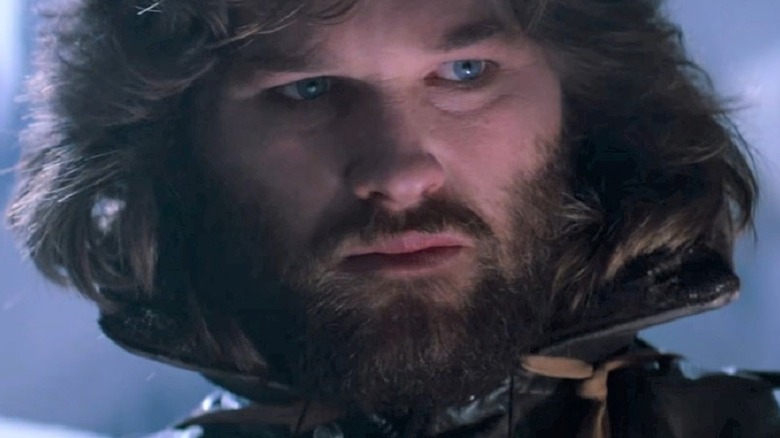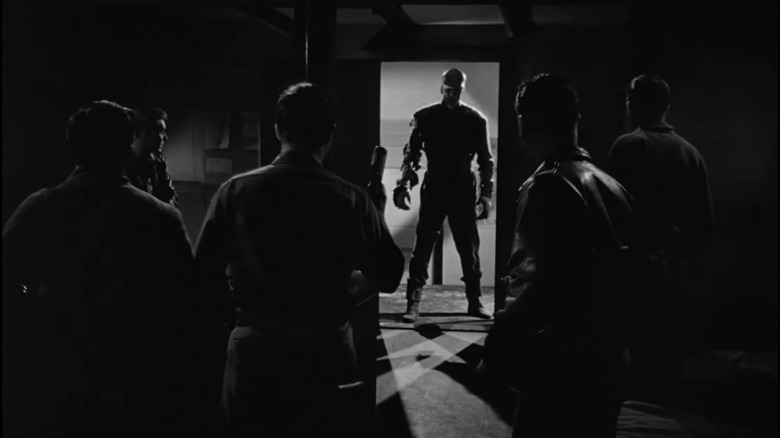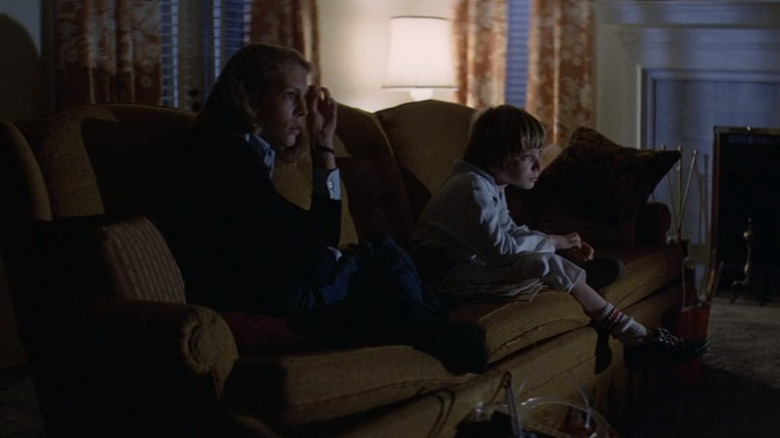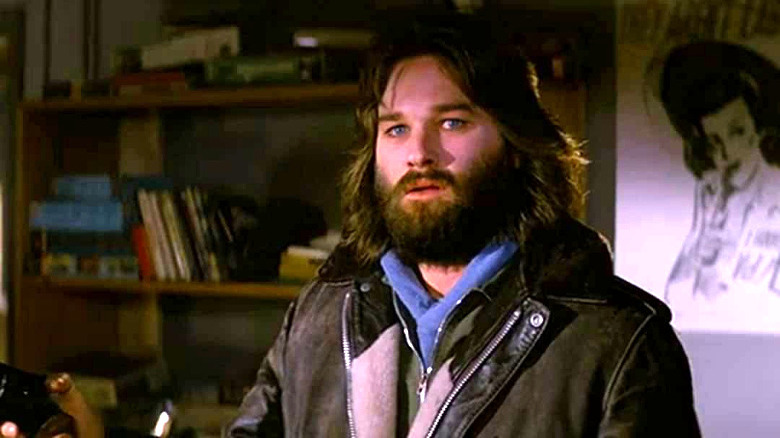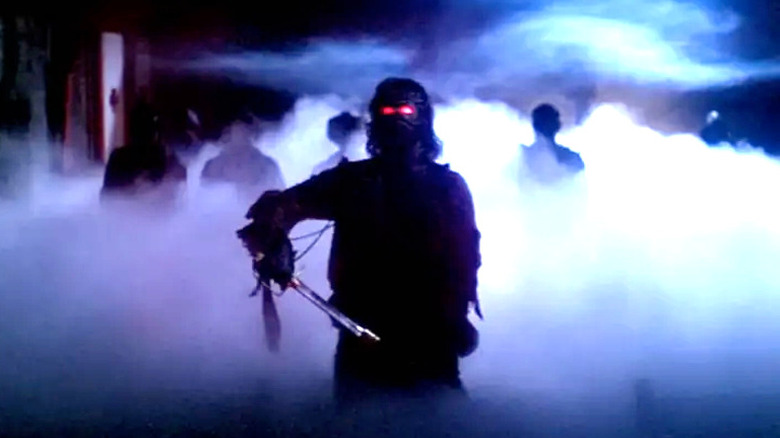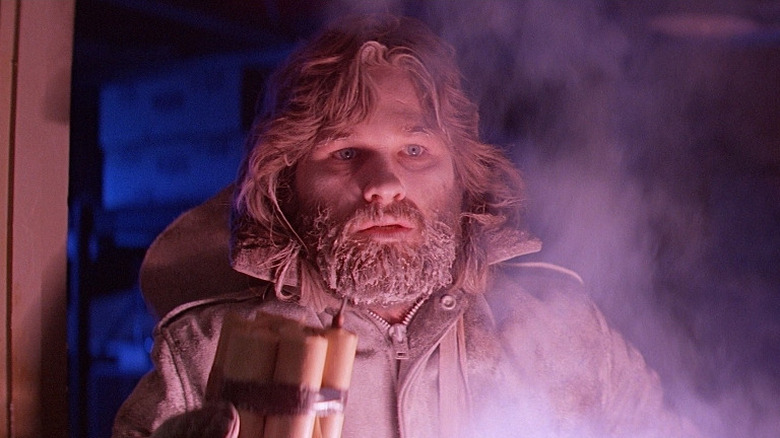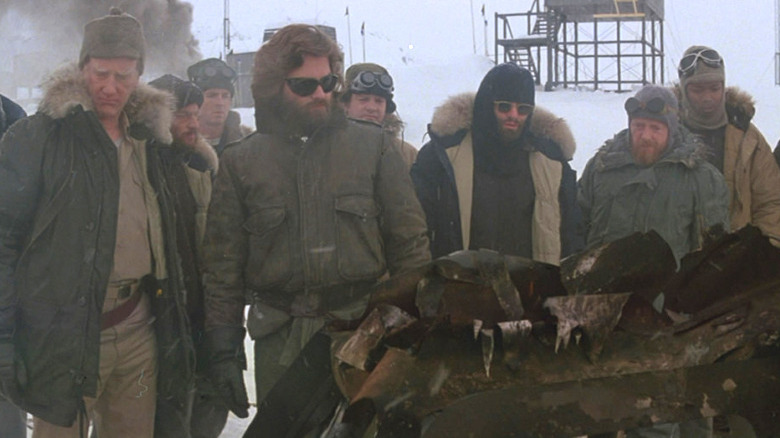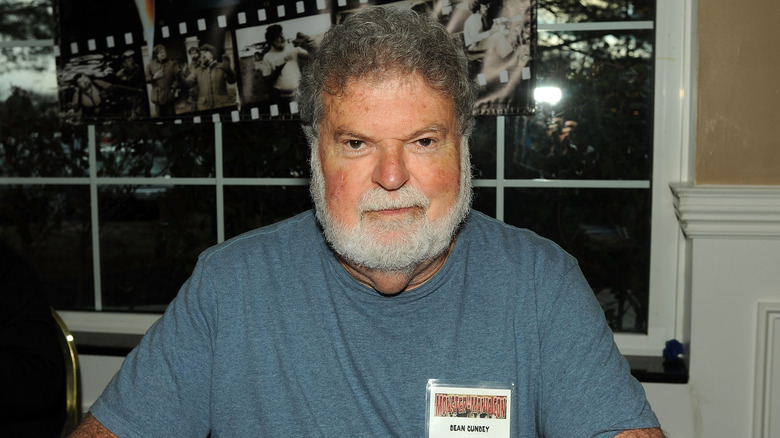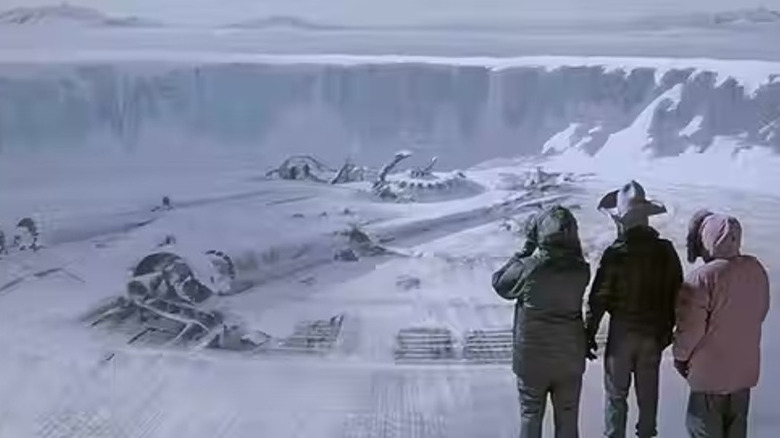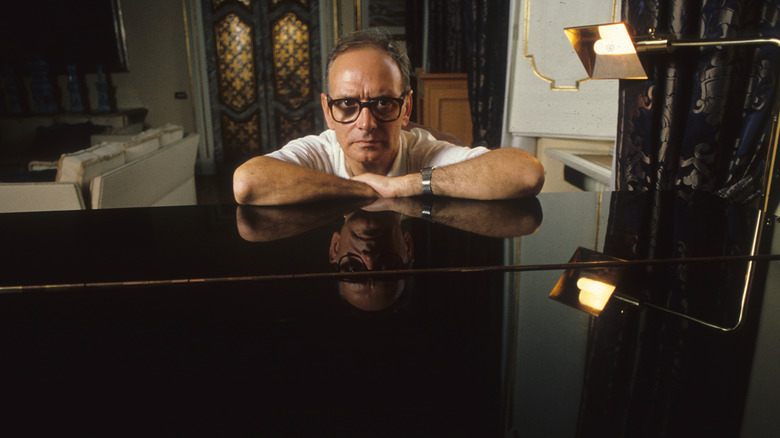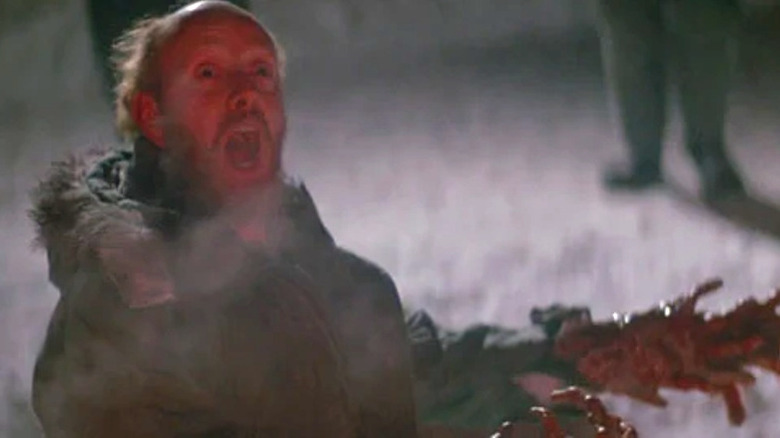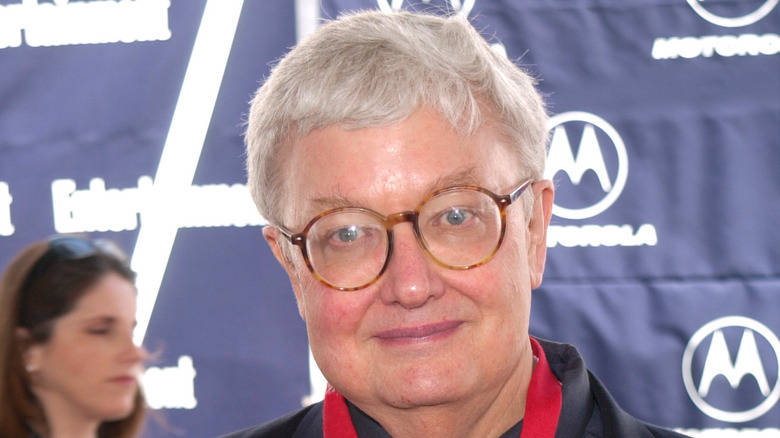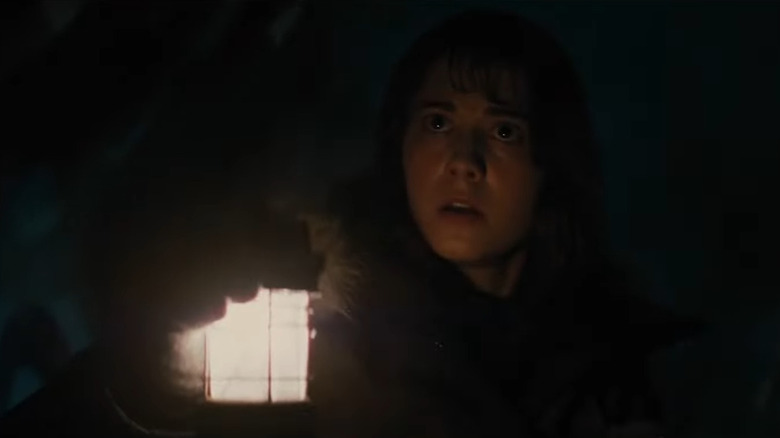The Untold Truth Of John Carpenter's The Thing
On June 25th, 1982, director John Carpenter released his biggest film to date — a remake of "The Thing from Another World" titled "The Thing." This was a huge step up for the filmmaker who'd previously helmed independent films like "Halloween" and "Escape from New York." While his output was already impressive, this studio remake was a chance for him to really pull out all the stops and make something mind-blowing.
In that goal, he succeeded masterfully. "The Thing" is a masterpiece. From its sense of isolation and paranoia to its groundbreaking special effects that continue to hold up four decades later, the film oozes dread and menace. Set in Antarctica, the film tells the story of a small research base that's been infiltrated by an alien entity able to mimic any organic form. Shortly after its arrival, the men on this base realize they can no longer trust each other as any one of them could be the Thing.
The film has stood the test of time. Not only is it the high watermark for practical effects, but the story can still pull in a crowd as evidenced by special Fathom Events screenings held across the United States resulting in the film making it into the top 10 weekend box office in June of 2022. In honor of its longevity, we'll be taking a look at some facts about the film even diehard fans may not be familiar with.
John Carpenter loved the original film
It's easy to forget now, but John Carpenter's "The Thing" was actually a remake of a 1951 sci-fi film directed by Christian Nyby and produced by Howard Hawks called "The Thing from Another World." Carpenter has always loved the work of Howard Hawks, describing his filmmaking technique as invisible. During an interview on "Movie Talk," he discussed his admiration for Hawks and described what it's like to watch one of Hawks' films, saying, "You think you're just watching a movie and watching actors. In reality, you're watching a master at work."
While speaking with the late Robert Osborne about "The Thing from Another World," Carpenter says he loved the film because it scared him as a kid. When he grew up and went to film school, he had a renewed appreciation for the movie because he recognized Hawks' influence. Although Nyby is the credited director, Carpenter says some of the cast members have reported that Hawks was the one directing them. The fact that "The Thing from Another World" was something of a nostalgic favorite — and a crucial part of his development as a film student — made him the perfect choice to remake it in 1982.
The original Thing was in Halloween
In 1978, Carpenter directed the horror film that would launch a thousand imitators and a series of sequels and reboots for the next four decades — "Halloween." Set on the titular holiday, the film sees the citizens of Haddonfield, Illinois, celebrating the spooky season with a masked serial killer in their midst. Halloween ambiance is all over this movie thanks to small touches, like the carving of jack-o-lanterns, dead leaves eerily blowing in the wind, and characters watching horror movies on television.
For example, while babysitting, Laurie Strode (Jamie Lee Curtis) sits on the couch with the boy she's looking after, and they're watching a scary movie. When the camera points to the screen, we see the iconic opening credits to "The Thing from Another World." Later, we see that young Lindsey Wallace (Kyle Richards) — another child being babysat — is also watching television. And again, we see that she's watching "The Thing from Another World." Even before he was ever up for the job of remaking the film, Carpenter was letting the world know how much he loved it.
Back to the source material
When John Carpenter signed on to direct "The Thing," he didn't want to simply do "The Thing from Another World" again. Instead, he went back to the John W. Campbell novella the original film was based on. In an interview with Creative Screenwriting, he was very honest about his reasons for doing this. It turns out that he held the film in such high esteem that the thought of recreating it was too intimidating.
His friend Stuart Cohen was producing the remake, and he suggested Carpenter re-read the book. "So he suggested I read the short story and see what I thought," Carpenter explained, "and it was Agatha Christie's 'Ten Little Indians' in many ways, but it was the creepiness of the imitation business and the questions that it brought up that I thought were really interesting."
The Thing in the 1951 film was a guy in a suit lumbering around the base — basically humanoid plant creature that consumes blood — but the creature in the original story was able to imitate living things. This was the main difference between Carpenter's film and the original. He and a team of artists crafted an unknowable creature that could be anything at any time, bringing out the same sense of paranoia that was in the book but missing from the first film.
Rob Bottin was in The Fog before creating the Thing
A major contributing factor to the continued success of John Carpenter's "The Thing" is the remarkable work done by special effects artist Rob Bottin. More often than not, state-of-the-art special effects fail to hold up when the next generation of FX tools hit the market. Thanks to Carpenter's decision to let Bottin go wild with ideas, "The Thing" contains images that still hold up remarkably well all these years later.
When Carpenter and Bottin first met, however, they didn't talk about special effects. In "John Carpenter's The Thing: Terror Takes Shape," Bottin explains he was such a massive fan of "Halloween" that he was desperate to meet and work with John Carpenter. While working on "Rock 'n' Roll High School" with cinematographer Dean Cundey, who shot "Halloween," he was given the opportunity to meet Carpenter during production on "The Fog."
In fact, Bottin actually burst his way into a meeting and asked Carpenter if he had any characters in "The Fog" similar to Michael Myers — because he would love to play him. Carpenter had Captain Blake, the ghost of a dead pirate traveling through the fog that was sweeping across a small seaside town. The part went to Bottin, and while working on that film, Carpenter offered him the special effects job on "The Thing."
Kurt Russell wasn't involved at first
It's hard to imagine "The Thing" without Kurt Russell as MacReady. That beard alone could serve as a mascot for the film. However, he wasn't always involved. Carpenter had worked with Russell previously on "Escape from New York." He played the character of Snake Plissken, a notorious criminal with a knack for surviving difficult situations. Based on that, the two became friends and would continue to work together on future projects.
During the early days of casting, though, Carpenter wasn't considering Russell for the part. During "Terror Takes Shape," Russell describes discussing casting with Carpenter as a friend and not as a potential lead. "He was casting the movie and had some of the other roles cast, pretty much, and he was not finding what he wanted for MacReady," Russell said.
"I guess it was about three weeks to go or a month, maybe less than that, he came to me and said, 'What would you think about playing it?'" At that point, Russell took another look at the script and decided it was something he'd like to be a part of.
Character dynamics were decided in rehearsals
The concept behind "The Thing" is that a group of isolated researchers are terrorized by a shape-shifting alien entity. In order for the film to work, it required more than just movie magic — excellent actors needed to make viewers believe that they were living, breathing human beings in truly dire circumstances. Not only that, but we also had to buy the idea that these men have been spending nearly every waking moment together for an uncomfortable amount of time.
To achieve this, Carpenter reserved two weeks prior to filming for rehearsals. As described by Richard Masur, who played the dog-loving Clark, Carpenter's instinct was, "Put this group of 12 people together and then try and figure out what the dynamics were going to be between them." This allowed them to work out who disliked who and what certain characters' reactions would be to given situations. "And we came up with a lot of very interesting stuff in that process."
By allowing the actors time to bond and experiment, their performances came across as more natural and confident than you might see in your typical alien picture. It brought the world to life in a way that no amount of special effects would be able to achieve on their own.
The imact of Dean Cundey
The director of photography (aka DP) is largely responsible for the look of a film. While the production designer creates the physical world of the film, it's the DP who filters that world through the lens of their camera while interpreting the needs of the director. While few DPs can be considered household names, there's a very strong possibility that images captured by Dean Cundey have been imprinted on your memory.
This is the man who shot "Halloween," the "Back to the Future" trilogy, and "Jurassic Park." He also worked with John Carpenter on "The Fog," "Escape from New York," and "Big Trouble in Little China." Cundey is such a master that Carpenter credits him as being 50% responsible for why his favorite scene in the movie works so well. The scene itself is when everything dissolves into chaos and the severed head of Vance Norris sprouts legs and skitters away.
Carpenter told fellow filmmaker Mick Garris, that he just hadn't seen anything like it before. "50% of it is Rob Bottin and his abilities as a special effects technician," he said. "And 50% was Dean Cundey lighting this stuff. Lighting it with enough light so you could see it but not too much where it gave it away." Without Cundey, we may not be talking about "The Thing" today.
The Apocalypse Trilogy
"The Thing" is thematically linked with two other John Carpenter films that he refers to as the Apocalypse Trilogy. The second film is 1987's "Prince of Darkness," and the third is 1994 film "In the Mouth of Madness." What connects them is an overwhelming sense of dread. Carpenter even pointed out in the commentary to "The Thing" that from the very first frame, there's a sense that the dog running across the ice signifies the end of all things.
While introducing the trilogy in 2011, Carpenter explained that his interest in the end of the world began in childhood. Growing up in the 1950s, he attended a school with teachers who read to their students from the Christian Bible. In third grade, his teacher read from the Book of Revelation, which details the end of the world. "It was the most confusing thing I ever heard in my life," the director said before praising the imagery.
He admits he still doesn't understand what was going on, but it birthed his fascination with the end of things. "I don't just mean a character but the order of things, the world — life on this world." While the Bible pointed him in the apocalyptic direction, fear of the atomic bomb solidified things. "I found out that we have the capacity to destroy ourselves," he said. "Someone could press a button, and these missiles would rain down on us." It's no wonder the apocalypse had been plaguing him for decades.
Ennio Moricone brought the tragedy
A John Carpenter score is synonymous with the film it's linked to. Once you've seen one of his films, it's hard to hear the music without remembering the images paired with it and vice versa. Before "The Thing," Carpenter had scored all of his films in the same low-key, atmospheric style. His work as a composer had become so iconic that in 2015, he began making albums of original music that stood shoulder to shoulder with his movie scores.
But when the time came to put music to "The Thing," Carpenter collaborated with legendary composer Ennio Morricone. Perhaps best known for his work on "The Good, the Bad and the Ugly," Morricone was already a prolific and intimidating figure before signing onto "The Thing." At first, Morricone's score didn't sit right with the director. "It was all way too flourishy and ornate," he told IndieWire shortly after the composer's passing in 2020. "I said to him, 'Ennio, use less notes.' And he did. That was the main title theme."
It's remarkable how similar the score ended up being to a classic Carpenter composition. However, Carpenter insisted that Morricone brought something special to the film with his work. "He brought it — this deep, tragic sense that this is the end of things, of everything. Oh my god, it really worked. I was delighted with it."
The Thing was a flop
It can be tempting to put a little too much trust in what a film makes at the box office, as if earning all the money in the world is an automatic indicator of a movie's quality. However, some films have trouble finding their audience right away. This doesn't mean the film is bad by any means. Instead, it means that the audience's expectations at the time were not met. Either the kinds of people who would have enjoyed the film didn't get a chance to go, or the taste of the masses wasn't quite attuned to a film's particular flavor.
Case in point: John Carpenter's "The Thing." Opening during a massive summer movie season which included both "Star Trek II: The Wrath of Khan" and "E.T. the Extra-Terrestrial," "The Thing" simply failed to reach blockbuster numbers. To put it into perspective, it was the 42nd highest-grossing movie of 1982, beaten out by titles like "Airplane II: The Sequel" and the re-release of "Bambi." Regardless of what American audiences felt about it at the time (according to Guillermo del Toro, the film did well in Mexico), it's obviously achieved iconic status now that audiences are ready to embrace its paranoid, nihilistic brilliance.
Critics hated it
Taking the words of film critics as fact can be tempting at times. After all, they see nearly every movie that comes out. They get paid to share their impressions with their readers. Surely they know what they're talking about. While these things are true, it's important to remember that critics — though very qualified to weigh in on the subject — are just people. The observations they share are just opinions.
For instance, when discussing the characters in "The Thing," Dave Kehr of The Chicago Reader wrote, "Although the group members are played by familiar, well-defined character actors, the terse banality of the dialogue makes them all sound and seem alike — it's hard to tell who's being attacked and hard to care." That may be his point of view, but there are likely thousands of audience members who would disagree.
Likewise, Roger Ebert called the film "the barf bag movie of July." Perhaps the most interesting insight, when compared to a modern audience's take on the material, came from Vincent Canby with The New York Times, who wrote, "'The Thing' is a foolish, depressing, overproduced movie that mixes horror with science fiction to make something that is fun as neither one thing or the other." He went on to bash the special effects and concluded, "There may be a metaphor in all this, but I doubt it."
The Thing has not been remade
Although practically everything either gets remade or rebooted, there are a select few that would be very tricky to pull off. L. Frank Baum's "The Wizard of Oz" may be in the public domain, but remaking the 1939 Judy Garland classic based on the book would probably cause some controversy. Remaking "The Godfather" might be a bad idea, likewise with 'Back to the Future." "The Thing" occupies a strange place as it is a beloved classic that still holds up, but it is itself a remake.
2011 saw the release of "The Thing" starring Mary Elizabeth Winstead and Joel Edgerton. When hearing about the film before its release, there was no indication that it was anything other than a straightforward remake of Carpenter's film. However, the movie is actually a prequel. Instead of setting things in the modern day, it takes place in 1982, the same year as the Kurt Russell film. The movie, essentially, tells what happened to the Norwegian Antarctic research station leading up to the opening scene of Carpenter's classic. Although the studio Blumhouse announced development of a reboot, at the time of this writing, John Carpenter's "The Thing" remains the definitive cinematic adaptation of John W. Campbell's novel.
